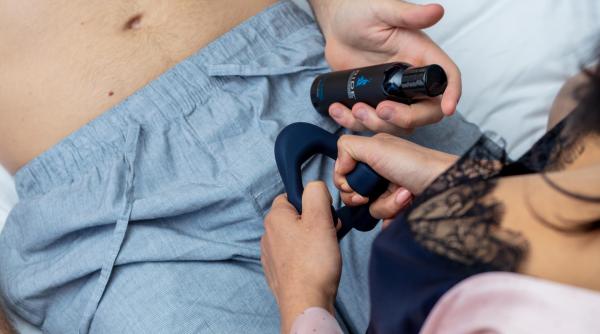Danielle Page on Women and Orgasms


By Danielle Page
If you suspect that your woman faked an orgasm, what are some ways to talk to her about it? Here’s how to ask about it in a polite, dialogue-encouraging way, how to be at peace with the fact that your partner has faked orgasms in the past, and some reasons for why she might have done so.
Confidence and Your Sexuality
The first question is to honestly think about how confident you are in your sexual ability and with your sexuality, and are you possibly doing something that might be uncomfortable for her?
Women, many times, will fake having an orgasm because they don’t want to hurt their partner's feelings. You need to be able to show her you have the confidence in yourself to be able to work with her to help her achieve orgasm.
So, how do you get that confidence if you aren’t comfortable talking about that yourself? Realize that women often have a lot of difficulties achieving orgasm, especially when they are with their partner. It has no reflection on either person, it’s just the way it happens to be. It’s also a wonderful opportunity to heighten your ability to please her and take a journey of discovery together. It’s not about you not being good enough -- it’s about you wanting to be better and having the confidence to face that.
Once you have come to terms with that yourself, tell her that you want to be able to please her more than you currently are.
Work Together with Her
Tell her you want to refine your abilities as a lover and would be honored if you could practice on her. Start with using your fingers, orally and sex toys. Make sure she can achieve orgasm with you focusing all your attention on her first. Also, understand that having an orgasm is ultimately her responsibility. Ask her if she can achieve orgasm by her self. If she’s not comfortable talking about that ask her to masturbate in front of you. Sometimes by doing that women become more comfortable sharing the experience when you’re stimulating them.
Only after you’ve been able to help her have orgasms (preferably multiple orgasms) via other means should you try this during intercourse. Also, understand that only about 25% or less of women can achieve orgasm from intercourse alone.
I recommend you first try to make sure she has at least 2 orgasms before you initiate intercourse. This will both increase the chances she can have more orgasms, and ensure she is adequately prepared for intercourse.
That brings up another point. Sometimes women have no pleasure from intercourse and experience pain. Vaginismus (pain during penetration) and vulvodynia (generalized pain in the entire region) are much more common that people realize because women are frequently embarrassed to talk about it. This can range from being mildly uncomfortable to unbearable. Women will sometimes fake orgasms just to hurry things up. This is where developing a close, honest relationship is important because this is an area she may need medical attention to improve. The good news is, this can usually be helped a great deal or completely resolved. But you have to talk about it first.
How common is it for a woman to be unable to orgasm during sex? What are some reasons why she's unable to do so? If your female partner tells you that she doesn't get off during sex, what are some ways to respond to that?
Studies indicate 75% or more women can’t achieve orgasm through intercourse alone. This is due to several reasons.
First, most women need clitoral stimulation to achieve orgasm. The distance between the glans of the clitoris and the opening of the vagina varies with women. Generally the closer the clitoris is to the vagina the more likely it will be stimulated during intercourse -- if you last long enough. Most women require 10-20 minutes of continual stimulation to achieve clitoral orgasm. So even if her anatomy is ideal for clitoral stimulation during intercourse, if you orgasm in 5 minutes she needed to go longer.
There are several positions where the woman or preferably her partner can stimulate her clitoris manually or with a vibrator during intercourse. This is a great way to help her.
Many women can achieve vaginal orgasm with enough practice and proper stimulation. But most women first need to be able to achieve this by separate stimulation by themselves and become familiar with the experience.
When this is done with intercourse it tends to require even more vigorous intercourse using the right techniques for 20+ minutes. So, to achieve this you have to maintain your erection and technique. Also, different sexual positions stimulate different areas (i.e., the G-spot, A-spot & O-spot).
If your partner says she can’t get off during sex, first understand that this is what usually happens. Women sometimes think it’s “their fault,” but it isn’t. It’s just how things happen many times. The question for you is: Are you up to learning how to please her this way with the understanding that she may not be able to? Some women won’t achieve orgasm from intercourse alone, but it if you think of it as a journey to share together, you can use the process to deepen your relationship and take your sex life to new levels.
One key thing to remember here is you don’t ever “give” women orgasms. By learning good techniques and being supportive, you can help them achieve them, but they are the one having the orgasm.
Another critical point is this isn’t a contest where you “win” if she achieves orgasm. It’s a shared experience and exploration of each other. If you view it as a contest, you aren’t honoring her as a person and will miss out on many things.
The “A-Spot” Orgasm
This is similar to the “G-Spot” orgasm, but is located deeper in the vagina, in the "anterior fornix” which is located deeper at the end of the vagina, facing upwards in the area above the cervix and below the bladder.
To stimulate this area you have to go as deep as possible with your finger and use a motion similar to the “come here” finger motion used in G-spot stimulation. Some women don’t like this and find it is painful or that it causes spasms. While others find it extremely pleasurable. This stimulation is most likely affecting more of the vagus and hypogastric nerves instead of the pudendal nerve that is associated with clitoral or possibly G-Spot stimulation. Women that enjoy this usually have facial flushing faster from this type of stimulation.
Dr. Chua Chee Ann (an MD sexologist from Malaysia) first reported about this in 1993 as a way to help women increase lubrication. Some women can achieve orgasm from it, some have to practice (specific techniques) and some can't achieve orgasm at all from this type of stimulation.
Usually, their partner will alternate between the A-Spot and G-Spot for variety. Positions that allow the deepest penetration are needed for the A-spot to be stimulated during intercourse.
The “O-Spot” Orgasm
This is the region at the end of the vagina below the cervix, facing towards the back of the woman’s body. This area is stimulated manually with a “come here” motion of the finger extended so it’s just below the cervix pressing downward. Some women describe a feeling similar to anal sex from this type of stimulation, which some enjoy and others don’t like.
Dr. Charles Runels was the first to describe this area in the last decade.
Some people believe that the O-Spot is being stimulated when a woman is in the “doggy style” position with her chest close to the bed and her back highly arched.








